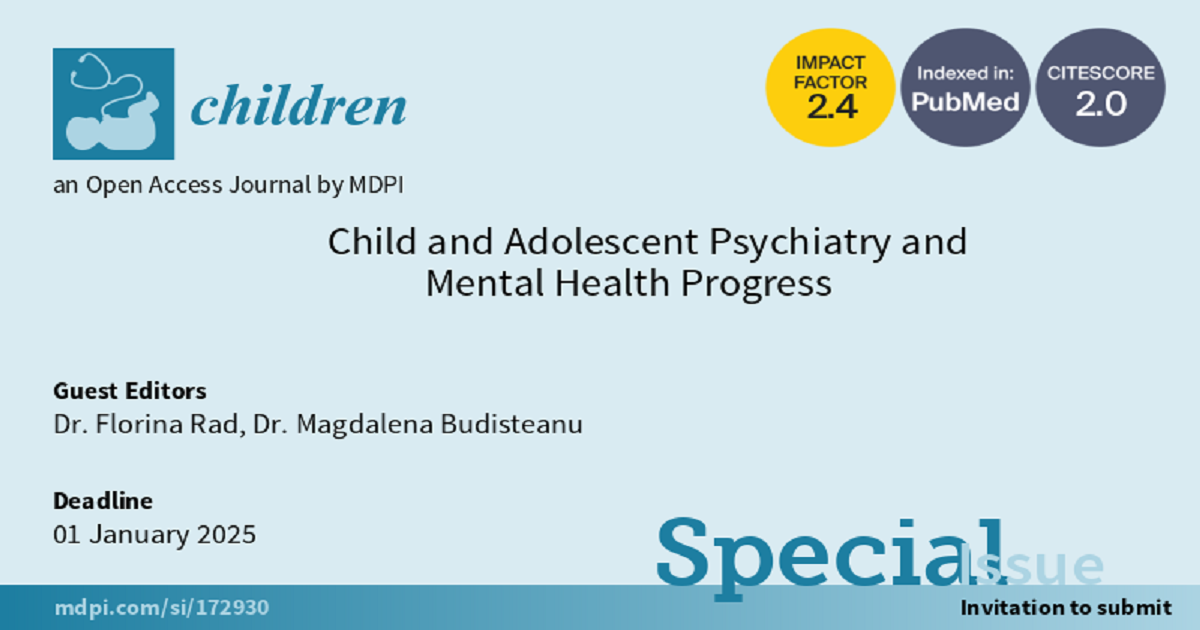Child and Adolescent Psychiatry and Mental Health Progress
A special issue of Children (ISSN 2227-9067). This special issue belongs to the section "Child and Adolescent Psychiatry".
Deadline for manuscript submissions: 1 January 2025 | Viewed by 17743

Special Issue Editors
Interests: neurodevelopmental disorders; eating disorders; depressive/anxiety disorders; psychotic disorders; child and adolescent mental health
Special Issues, Collections and Topics in MDPI journals
Interests: neurodevelopmental disorders; pediatric neurology; eating disorders; depressive/anxiety disorders; psychotic disorders; child and adolescent mental health; rare pediatric neurological diseases
Special Issues, Collections and Topics in MDPI journals
Special Issue Information
Dear Colleagues,
Considering the challenges of the health system regarding the increased prevalence of mental health disorders in patients with increasingly younger ages, we consider that the launch of a new Special Issue that addresses the mental health of children and adolescents is incredibly necessary.
Early life mental health issues do not just produce disabilities at an individual level but determine maladaptive reactions in the family environment, social or community disruptions, low academic productivity, and increased healthcare costs. These negative consequences have reached alarming levels, especially in the last few years in the context of the pandemic.
More than half of all mental health disorders develop before the age of 18, and in this context, we kindly welcome you to disseminate new scientific information and updates related to new concepts and psychiatric approaches in order to create better outcomes for children and adolescents struggling with mental health disorders.
Considering the success and popularity of the previous Special Issue, “Child and Adolescent Psychiatry and Mental Health”, published in the journal Children (https://www.mdpi.com/journal/children/special_issues/D57G2A3626), we are now releasing a second Issue aiming to highlight recent advances, innovative views on diagnosis, therapeutic approaches, and novel standards regarding neurodevelopmental disorders, conduct disorders, psychotic disorders, addictive disorders, and depressive/anxiety disorders diagnosed in children or adolescents. We also encourage submissions that explore the influence of psychiatric diagnosis on family or siblings’ functionality. On behalf of the Editorial Office, we invite you to submit research papers, review articles, and interesting case reports for peer review and possible publication.
Dr. Florina Rad
Dr. Magdalena Budisteanu
Guest Editors
Manuscript Submission Information
Manuscripts should be submitted online at www.mdpi.com by registering and logging in to this website. Once you are registered, click here to go to the submission form. Manuscripts can be submitted until the deadline. All submissions that pass pre-check are peer-reviewed. Accepted papers will be published continuously in the journal (as soon as accepted) and will be listed together on the special issue website. Research articles, review articles as well as short communications are invited. For planned papers, a title and short abstract (about 100 words) can be sent to the Editorial Office for announcement on this website.
Submitted manuscripts should not have been published previously, nor be under consideration for publication elsewhere (except conference proceedings papers). All manuscripts are thoroughly refereed through a single-blind peer-review process. A guide for authors and other relevant information for submission of manuscripts is available on the Instructions for Authors page. Children is an international peer-reviewed open access monthly journal published by MDPI.
Please visit the Instructions for Authors page before submitting a manuscript. The Article Processing Charge (APC) for publication in this open access journal is 2400 CHF (Swiss Francs). Submitted papers should be well formatted and use good English. Authors may use MDPI's English editing service prior to publication or during author revisions.
Keywords
- child and adolescent psychiatry
- neurodevelopmental disorders
- depressive disorders
- anxiety disorders
- psychotic disorders
- addictive disorders
- siblings’ mental health
Related Special Issue
- Child and Adolescent Psychiatry and Mental Health in Children (9 articles)






